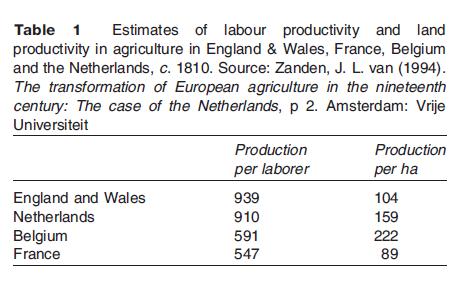The Early Modern Period
A slow recovery started during the fifteenth century and continued during the 'long sixteenth century'. A new phase of economic integration started during this period, in which the European economies and landscapes re grouped around northwestern Europe, the only re maining core region. The main center of trade moved within the core region from Antwerp (sixteenth century) to Holland (particularly Amsterdam, seventeenth cen tury) and England (eighteenth century). Around this core, Von Thu?nen like zones can be distinguished, with the most intensive agriculture, including dairy farming and horticulture in the core region itself, with large scale grain growing extending along the Baltic and with ex port oriented breeding of cattle and horses in regions such as Jutland and Hungary. Around the Baltic Sea, grain growing estates could compete with competitors closer to the urbanized core region by eroding the pos ition of their tenants and so reducing their labor costs. Here, a countryside of small farmers developed into a land of large estates with forced labor. On a smaller scale, Von Thu?nen like zones can be distinguished around the urbanized region of northern Italy and within the Otto man Empire (around the town of Istanbul).
In some parts of Europe large areas of land were re claimed. In the Netherlands, for example, the draining of lakes started in the first half of the sixteenth century, but reached a summit during the first half of the seventeenth century. In the second half of that century, lower prices for agricultural products made new reclamations un economic and the draining of natural lakes stopped for two centuries. In Central and Eastern Europe a new wave of settlers, many of them fleeing for religious pros ecutions, settled in thinly populated or partly de popu lated regions. Reclamations, but also the needs of a growing population, led to an increasing pressure on forests and common lands. All over Europe during the sixteenth century people complained about disappearing or degrading forests.
In most regions, however, the emphasis was on im provements in agriculture. This period showed an in creasing specialization in many regions. In the Low Countries, around the staple market of Amsterdam, an intensive and commercial agriculture developed, in which large inputs and modern methods brought high yields per hectare. In the European core region, par ticularly in the Netherlands and in England during the seventeenth and eighteenth centuries, the spread of crops such as clover and turnips brought higher arable yields, as well as extra animal fodder. The introduction of new crops such as potatoes in northwestern Europe and maize in Mediterranean Europe gave high yields per hectare and made larger rural population densities possible. These innovations were part of what was later called the 'agrarian revolution'.
In some regions, very intensive and balanced types of farming developed. In the semiperipheral sand belt of the southeastern Netherlands and the adjoining parts of Belgium, Germany, and Denmark, the remaining com mons were more strongly integrated into the agrarian system, when the manure of cattle and sheep was mixed with sods – the so called 'plaggen' – and used for fer tilizing the arable. It led to a huge transport of organic and mineral materials from the commons to the arable. The system remained in use until the end of the nine teenth century.
Specialized crops, such as hemp, hop, and tobacco, became important for specific regions. Some regions, particularly close to urban centers, specialized in dairy farming or horticulture. In regions that changed from grain to cattle, the old open fields became dysfunctional and were often enclosed. Within a few decades open landscapes became characterized by hedges and dis persed farms. During the sixteenth and seventeenth centuries, this happened, for example, in parts of the Allga?u in southern Germany and in the country of Herve near the industrial town of Lie`ge (Belgium).
But also for the remaining arable regions, the old open fields were no longer the optimal landscape. The more complex rotations led to a more individual management of the open fields. Most of the new reclamations were highly individualized, with enclosed fields and dispersed farms. Enclosures were now also being applied in open fields that remained in use as arable. In England, the enclosures speeded up during the phase of parliamentary enclosure (from 1720). Elsewhere in Europe, enclosures took place on a small scale during the fifteenth and six teenth centuries, but became large scale during the eighteenth and nineteenth centuries, particularly in southern Scandinavia (eighteenth century) and parts of Germany (eighteenth and nineteenth-century).
Table 1 shows some interesting differences within northwestern Europe. Whereas in the UK the emphasis was on increasing labor productivity, the more densely populated and more urbanized Low Countries show particularly increases in land productivity. This is the main explanation for the early enclosures in the UK; in the Low Countries, a reconstruction of the field pattern was less urgent and enclosures (ruilverkavelingen) only started during the twentieth century. France is yet an other story, being characterized by a less intensive agri culture in terms of labor, as well as land productivity. Here also, the enclosures (remembrements) only started during the twentieth century.
